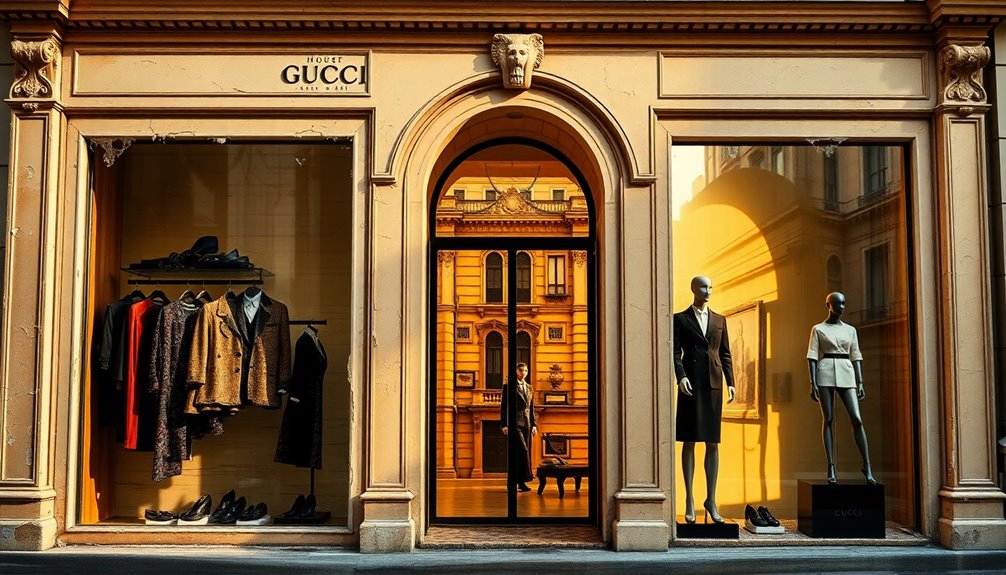The House of Gucci, founded in 1921, faces challenges amid shifting consumer expectations and internal rivalries. With new leadership under Sabato De Sarno, the brand aims to modernize by merging men's and women's collections and embracing inclusivity. This transformative approach is designed to resonate with younger consumers and redefine luxury fashion. As Gucci navigates these exciting yet risky changes, there's much more to uncover about its potential revival and future direction.
Key Takeaways
- Gucci's legacy is marred by family rivalries and financial struggles, prompting the need for a transformative revamp to regain control and direction.
- New creative director Sabato De Sarno aims to redefine Gucci by merging masculine and feminine styles, appealing to modern consumer preferences.
- A focus on inclusivity and cohesive seasonal collections is essential to resonate with younger consumers and adapt to shifting fashion trends.
- Historical transformations in leadership have demonstrated the potential for innovation, suggesting that a new approach could revitalize Gucci's market presence.
- Gucci's evolving aesthetic and strategic direction may influence broader luxury fashion trends and enhance its profitability in a competitive market.

As Gucci steps into a new era, you can see how the brand is redefining luxury with its upcoming revamp. Founded in 1921 by Guccio Gucci as a luxury luggage brand, Gucci's legacy has been shaped by family involvement, sibling rivalries, and significant challenges. By 1993, the family lost control due to financial struggles, highlighting the difficulties often faced by family-run fashion companies.
Now, with a fresh perspective under Sabato De Sarno's leadership, Gucci is poised for transformation. De Sarno emphasizes fluidity between masculine and feminine styles, setting the stage for a groundbreaking approach. You'll notice this shift with the plan to hold three unified fashion shows in 2025, merging men's and women's collections. This decision to present three unified fashion shows reflects the brand's commitment to a cohesive narrative that transcends traditional fashion boundaries.
This move reflects a broader trend towards inclusivity, challenging traditional gender norms and appealing to younger consumers. The innovative direction aims to create cohesive seasonal collections that resonate with evolving consumer preferences. In recent years, the fashion industry has seen a rise in celebrity lifestyles influencing design trends, which further supports Gucci's inclusive vision.
Each strategic transformation in Gucci's history—like Dawn Mello's focus on quality and reduced availability, and Tom Ford's modern branding—has involved risk-taking and innovation. Now, as Gucci embraces a more fluid and modern aesthetic, it may set new standards for luxury fashion presentations.
You can expect other brands to take notice and possibly rethink their own strategies in response. The market reception of Gucci's new approach has been positive, suggesting that the brand's evolution could lead to increased profitability and enhanced brand power.
As consumer attitudes shift towards inclusivity, Gucci's initiatives align perfectly with these evolving preferences. This isn't just a fashion brand revamping; it's a cultural shift.
Gucci's influence extends beyond clothing, impacting how luxury is perceived and consumed. As you observe Gucci's journey, you can see a storied house not only facing a turning point but also harnessing its rich history to pave the way for a dynamic future.
Frequently Asked Questions
What Is the History Behind the House of Gucci's Founding?
The House of Gucci started with Guccio Gucci, who was born in Florence in 1881.
After working in London, he returned to Florence in 1902, dreaming of creating luxury luggage. In 1921, he opened his first boutique, offering fine leather goods.
As the brand grew, his sons joined, expanding Gucci globally. Despite facing internal conflicts and financial struggles, Gucci established itself as a symbol of Italian craftsmanship and luxury, influencing fashion for decades.
Who Are the Key Figures in the Gucci Family Saga?
In the gripping Gucci family saga, you'll encounter key figures like Guccio Gucci, the brand's bold founder.
His sons, Aldo and Rodolfo, played pivotal roles, with Aldo's ambitious expansion and Rodolfo's star power.
Maurizio, the contentious heir, clashed with Paolo, the design chief, while Patrizia Reggiani's dramatic influence can't be overlooked.
Their familial feuds and fierce ambitions shaped Gucci's legacy, intertwining personal and professional challenges in a captivating narrative.
How Has Gucci's Brand Identity Evolved Over the Years?
Gucci's brand identity has evolved significantly since its founding in 1921.
You'll notice how it transitioned from a focus on craftsmanship to embracing modern luxury through various artistic directors. The introduction of iconic logos, like the double "G," reflects this shift.
Over the years, Gucci has adapted to changing consumer expectations, balancing tradition with innovation.
This evolution keeps the brand relevant, appealing to new generations while honoring its rich heritage.
What Controversies Has the House of Gucci Faced in the Past?
The House of Gucci has faced numerous controversies over the years.
You've seen the family feuds, especially between Maurizio and Patrizia, which culminated in Maurizio's shocking murder.
Legal issues, like Aldo's imprisonment for tax evasion, have also tainted the brand's image.
Additionally, Maurizio's financial struggles and the subsequent loss of family control further complicated Gucci's legacy.
These scandals have certainly impacted the brand's reputation in the luxury fashion world.
How Does Gucci Compare to Other Luxury Fashion Brands?
When you compare Gucci to other luxury fashion brands, you notice its boldness stands out.
You see how Gucci's experimental designs attract a younger crowd, while brands like Louis Vuitton lean towards classic elegance.
Both share a commitment to craftsmanship, but Gucci's focus on sustainability gives it a modern edge.
As you explore their histories, you'll realize Gucci's cultural impact often resonates more with today's fashion-forward consumers.
Conclusion
As the House of Gucci stands at a crossroads, it's clear that a gentle metamorphosis is in the air. While whispers of change may seem daunting, they could usher in a new era of creativity and innovation. Embracing this transformation could breathe fresh life into the storied brand, allowing it to flourish once more. So, let's not fear the winds of change; instead, let's welcome the opportunity to reinvent and reimagine what Gucci can truly become.










